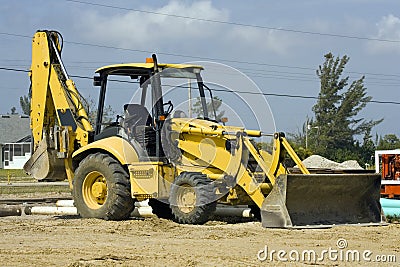Tractor shovel
It is essentially a diesel operated tractor with a bucket as the front attachment and is called a front-end loader or pay loader. It may be on pneumatic tyres or crawler chains. The tractor shovel attachments consist of a push frame and a bucket that can be raised, lowered and dumped hydraulically or mechanically. The shovel usually has a pusher fan so that the dirt falling from the bucket will not be sucked back towards the operator and engine air intake (fig. 5.5.)
For digging, the complete tractor shovel has to move forward towards the bench and for unloading the contents of the bucket the entire unit has to come back and position itself conveniently to empty the bucket on to a dumper. Its rate of digging and loading cannot, therefore, be as fast as with a revolving shovel,-described later.
Main specifications of two wheel-loaders (B.E.M.L)

WA 200-1 Model-3035
| Bucket capacity m3 | 1.5 | 3.3 |
| Heaped 2:1 (SAE) m3 | 1.7 | 3.8 |
| Flywheel H.P, | 108 at 2,400 RPM | 300 at 2,100 RPM |
| Max. Travel Speed Forward, km/hr | 37 | 31.6 |
| Dumping Reach, mm | 1,025 | 1,300 |
| Turning Radius, mm | 5,620 | 6,300 |
| Overall Height, mm | 3,190 | 4,075 |
| Length, bucket on ground, mm | 6,715 | 9,200 |
Tractor shovels have been employed in some mines to load the stacked mineral at the siding into railway wagons or to push it into ground-level bunkers. Capacities of the buckets are from 0. 57 m3 upwards. Heavy rock buckets for handling blasted rock carry teeth as standard equipment, though the buckets used for coal handling need not be so equipped.
An excavator, technically speaking, is any machine which excavates the rock or earth and swings or transports it, within narrow limits, to an adjacent place or dumps it on to a receptacle like a dumper or railway wagon. In this sense, a tractor shovel which cuts or digs to some extent below the floor on which it stands, may well be considered an excavator—the nametraxcavator for the tractor shovel manufactured by one company aptly conveys the meaning—but, in earthmoving terminology the term excavator covers machines of the following type:—
1) Power shovels like dipper shovels, stripper shovels and back-hoes or pull shovels.
2) Draglines
3) Bucket wheel excavators.
A power shovel is a shovel using electric or diesel motive power for its operation, as distinct from a hand-operated shovel. The functions of power shovels are very simple. Basically, these machines lift fragmented rock, and swing it to a different location such as dumpers or spoil heaps.
The main components are:
1) Propelling arrangements consisting of either crawler chains or pneumatic tyres.
2) A deck or cab mounted on a turn table and housing the prime mover, all the controls for operation, cable (wire rope) drums and the operator's seat. The deck or cab can swing through 360" independently of the propelling crawler chains or tyres.
3) Deck swinging mechanism. When the deck swings, all the equipment mounted on it, including the boom and the bucket, also swings.
A shovel is made in three structural divisions. Anatomically, the top or revolving unit is the head and torso, the mounting or travel unit is the legs, and the various attachments are the arms and hands. A revolving and a travel unit together make up a basic shovel which may be fitted with any of the five front attachments shown in fig. 5.6. The machine may thus become any one of the following: a crane, a clam shell, a dipper shovel, a drag line, a pull shovel or a back-hoe.



I love the way you write and share your niche! Very interesting and different! Keep it coming! Loading shovel jobs
ReplyDelete